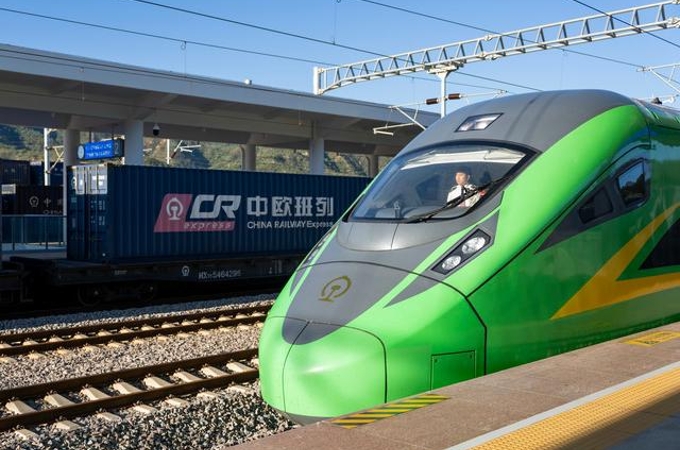'Green Silk Road' a major step on clean energy journey
Source: China Daily | 2023-09-25 | Editor:Rachel
The world's biggest single-site PV plant, built with Chinese expertise, underlines the UAE's desire to tackle climate change. Wang Yuke reports from Hong Kong.
In a desert some 50 kilometers from downtown Abu Dhabi, there is nothing but neat rows of solar panels surrounded by lattice towers, with some sophisticated utilities at one end.
Observers are often stunned by the isolation, the immensity of Mother Nature, amid this sprawling 21-square-kilometer stretch of land.
However, unlike barren deserts, this area, equivalent to 2,800 soccer fields and more than an hour's drive from the capital of the United Arab Emirates, radiates vitality.
The 2-gigawatt Al Dhafra solar power plant — the world's largest single-site photovoltaic power plant — lights up about 160,000 households with a constant supply of clean electricity. The brains behind the venture are 5,000 workers assigned to the Belt and Road Initiative: a global infrastructure development strategy launched by China in 2013 to link Asia with Africa and Europe and drive trade and economic growth.
It takes guts to venture into the scorching summer heat of up to 43 C. Just a few minutes' exposure to the ultraviolet rays and heat could give you vertigo and set you on fire. The sun's glare is so piercing that without sunglasses your eyes would sting and run dry.
It seems incredible that a PV solar project of such magnitude and significance was completed amid the COVID-19 pandemic and the relentless heat. So, why is the UAE — an energy giant with vast fossil fuel reserves — so determined to undertake an energy transition and become a global clean energy powerhouse?
There is a real need for change, according to Abdulaziz Alobaidli, chief operating officer of Masdar, the UAE's flagship renewable energy company and a major developer of the Al Dhafra solar power project.
The country has benefited from the underlying "wisdom of its leadership", which has been dynamic in thinking about the future, Alobaidli said.
"We need to diversify our economy and energy resources to improve our energy security," he added, noting that relying on a single energy source would be a risky strategy.
For Alobaidli, decarbonization is a necessity rather than a luxury or privilege. "We're committed to decarbonizing the value chain of all processes relating to energy, upstream and downstream," he said.
He added that as climate change is a global issue, the UAE feels compelled to share its knowledge and solutions to support collective efforts to reach net zero by 2050. This is a tenet of the 2015 Paris Agreement on climate change.
Wang Jinwei, general manager of the Abu Dhabi branch of China Machinery Engineering Corp, said that while fossil fuels are a carbon-intensive resource for electricity, they are subject to market fluctuations and cannot promise a secure supply of power.
So, the "Clean Energy Strategic Target 2035" campaign, launched by the Abu Dhabi Department of Energy, aims to see 60 percent of the region's electricity generated by clean, renewable sources by 2035.
It is the first legally binding clean and renewable energy target in the Middle East, and integral to Abu Dhabi's energy transition process.
Determined to do its part for the "Green Silk Road", CMEC, headquartered in Beijing, secured the $1 billion engineering, procurement and construction contract to build the Al Dhafra solar photovoltaic project. 
The plant, now fully operational, is expected to help Abu Dhabi slash its annual carbon dioxide emissions by 2.4 million metric tons, raising the proportion of clean energy in the UAE's total energy mix to more than 13 percent. That's equivalent to removing about 470,000 cars from the roads.This huge swathe of desert is neither distant nor silent as the relative serenity is punctuated by occasional creaks and squeals."They come from the solar modules (panels) rotating in sync with the sun's radiance as it shifts through the day. Capturing the largest possible amount of sunlight ensures maximum electricity generation. No solar energy should be wasted," Wang said, noting that the angle of the panels varies throughout the day, the steepest being at dusk and dawn.When the panels lie flat, face up, at about 7 pm each day, a cleaning routine begins. The film of sand collected on each panel's surface hampers the absorption of the sun's rays and electricity generation, so cleaning is an important job, Wang said.While water is the conventional medium for cleaning panels, it's not the case in Abu Dhabi because of the meager rainfall. "So, we came up with cleaning robots, an automatic substitute, after brainstorming with locals who are better acquainted with the conditions," he added.
Record-breaking feats
Alobaidli said the Al Dhafra solar project is a testament to China's expertise and competence. It reinforces how China's solar manufacturing sector is supporting regions participating in the BRI to meet their zero-carbon targets. The solar project has put the China-UAE relationship on the BRI map and broken many records in the process.
Despite global supply chains being thrown into disarray by the COVID-19 pandemic, CMEC completed the Al Dhafra project on schedule.
"We were installing almost 20 megawatts a day, setting a record. When we started our renewable energy journey, specifically solar energy, in 2010, it took a year to build a 10-megawatt plant in Masdar (a sustainable community). In the large-scale Al Dhafra PV project, thanks to experienced contractors such as CMEC, we were able to install 20 megawatts every day," Alobaidli said. The project involved obtaining 4 million bifacial solar PV modules from the Chinese mainland to be mounted on 30,000 single-axis sun trackers. "More than 10,000 containers were used to ship the modules. It was challenging," Wang said.
He added that the desert's complex and varied topography posed many engineering problems.
The site's proximity to the sea means the subsoil is highly saline and alkaline. To protect the piles, whose ends go deep into the ground, from corrosion, concrete had to be poured into the holes during piling works.
The high water level to the northeast caused the soil to collapse during the piling process, so sunken soil choked the burrowed holes. The solution was to insert plastic tubes to anchor the soil before burrowing.
Loose soil in the dune-dominated southeastern region was a problem until it was displaced and concrete was substituted to provide a more stable structure.
Building the 400 kilovolts GIS(gas-insulated switchgear) substation was also demanding. "It had to be scrutinized by Abu Dhabi Transmission and Despatch Co, which adheres to (one of the most) rigorous, hard and fast standards," Wang said.
The rigorous vetting and approval process also hindered construction. "But we still made it within 22 months, which would have been 35 months under the local timeline. It had registered 14 million safety work hours by early June," he said.
According to Alobaidli, the plant serves as a "blueprint" for upcoming projects of the same size and magnitude in Abu Dhabi. In addition to its environmental merits, the project boosted the local labor market.
"At the peak, we had more than 4,000 workers from various countries living in the UAE. A lot of local subcontractors benefited from the project and offered people full-time jobs," he said.

If the solar plant's impact may not be immediately obvious, a tour of Abu Dhabi illustrates how charging stations are a fixture of the cityscape and a reminder that the city has applied decarbonizing transformation strategies to its transportation system."With our partners, we look to ensure an entire zero-emissions fleet of taxicabs by 2040," said Abdulla Al Marzouqi, director-general of Abu Dhabi's Integrated Transport Centre, a subsidiary of the country's department of municipalities and transport.He hailed Shenzhen, Guangdong province, as one of the few success stories in the green public transportation transformation, and said it will be a model for the UAE. He noted that Shenzhen Bus Group is the first and largest operator of pure electric transportation, with about 10,000 such vehicles. "They will provide us with support and guidance: from drafting electric transport policies to assessing electric transport operational efficiency," he said.Now, new energy sector companies from the Chinese mainland are taking intellectual and technical assets, as well as technological standards, overseas. "From upstream — such as solar energy production and energy storage services — to downstream, where EV companies are coming to the Middle East," said Hallie Liao, general manager of KMB International, Shenzhen Bus Group's parent.
Exchange of knowledge
China has liaised with countries and regions participating in the BRI, hoping to address the problem of climate change. Despite that, some international commentators complain that the country is tightening its grip on the renewable energy chain.
Loai Sharkawi, an EPC (engineering, procurement and construction) construction manager with the PV solar project, has experience of the cross-pollination of knowledge driven by the partnership.
Standing at an oval table, where an oversized strategy map was unfurled and a projector flickered overhead, he led a team of engineers, contractors and suppliers in a frenzied discussion as they gesticulated, scribbled notes and picked each other's brains.
Inspecting the "road map", as Sharkawi called it, and brainstorming feasible solutions when work deviates from the expected course is a regular routine, he said. There is a free flow of knowledge and transparency of techniques, without the need to keep knowledge and information to oneself, which he appreciates.
All the skills picked up during the project will become strong points on his resume. "I'll carry the knowledge into my future career, projects, other companies, developers and owners to help make the planet green," he said.
Alobaidli said: "As a technology agnostic company, we're open to working with manufacturers, investors and EPC partners from all over the world. We have never found ourselves in a difficult situation where we have had to only work with Chinese (entities)."
What drives them to develop a sustained partnership is when they see the technical and economic value a partner can bring and the contractor or investor is on the same wavelength, which is a recipe for the collaboration with China, he added.
Meanwhile, Quentin des Cressonnieres, general manager of Engie Services Kuwait, said, "China is at the top of the clean energy innovation, with its forte being cost-effective manufacturing facilities: high-capacity factories to produce solar panels."
In an open-source world, there is little concealment of information or knowledge. "With Chinese contractors and all the others as well, we can maintain a very transparent and reciprocal relationship," he said.
Man Hau-chung, dean of the Faculty of Engineering at the Hong Kong Polytechnic University, said there have always been skeptical voices "because everyone (from the international community) wants the whole cake. They don't want to share it with you, but Chinese policies for the BRI are all about sharing. We're helping developing countries along the Green Silk Road build infrastructure and develop renewable energies and transport."
These things are their lifelines, he said, adding that he envisages a more powerful dynamic in green energy globally in the future.
You May Like
-
BRI to help create a more balanced world: Antwerp-Bruges Por...
A senior official with the Port of Antwerp-Bruges in Belgium says the China-proposed Belt and Road Initiative (BRI) will help to create a more balanced world.
InKunming 2023-09-25 -
Russia 'highly acclaims, actively supports' BRI
Russian President Vladimir Putin spoke highly of the Belt and Road Initiative and praised President Xi Jinping's "strategic judgment" of the world situation, in...
InKunming 2023-09-22 -
Interview: BRI significant in bringing prosperity, giving st...
The BRI will "give a stronger voice to those not having a voice at the moment," said David Ferguson, honorary chief English editor of the Foreign Languages Pres...
InKunming 2023-09-20 -
Europe urged to end prejudices on BRI
Europe should overcome its prejudices against the Belt and Road Initiative, as the China-proposed vision has a positive role to play in tackling the dire econom...
InKunming 2023-09-08 -
Chongqing: The BRI Gateway
Chongqing is the bustling metropolis that marks the connection point of the Belt and Road and Yangtze River Economic Belt. In 2013, Chinese President Xi Jinping...
InKunming 2023-09-08 -
BRI project enriches life of Croatian truck driver
InKunming 2023-09-05 -
Xinhua Commentary: China-Africa cooperation ushers in better...
Looking ahead, China will work with Africa to enhance the synergy of their development strategies, and will continue to support Africa in speaking with one voic...
InKunming 2023-08-27 -
Deer Show | BRICS Beat: Uniting Dreams, Shaping Futures
Just dropped our new track "BRICS Beat: Uniting Dreams, Shaping Futures!"A musical journey from Shenzhen to Jo'burg, capturing the glory, prosperity, and innova...
InKunming 2023-08-27 -
China-proposed BRI provides solid platform for international...
The China-proposed Belt and Road Initiative (BRI) has provided a solid platform for international cooperation, said speakers at an international symposium held ...
InKunming 2023-08-27 -
Why more countries show interest in joining BRICS
In the past few days, news has spread about the desire of many countries to join the BRICS, an international cooperative composed of five emerging economies, ...
InKunming 2023-08-15







